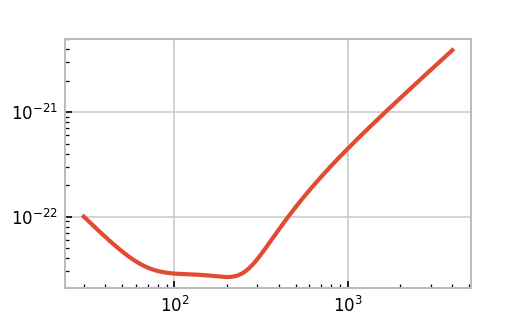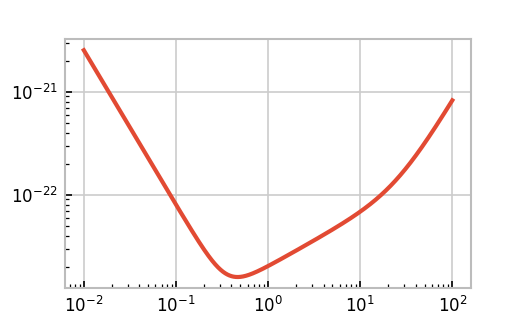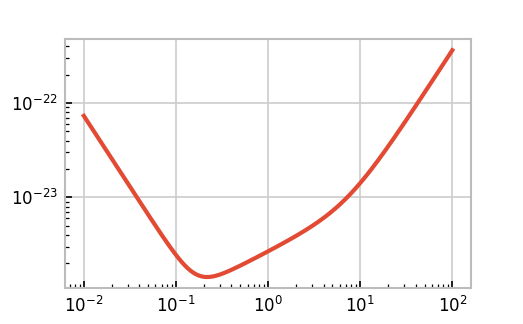The Interferometers Module¶
-
class
gravpy.interferometers.AdvancedLIGO(frequencies=None, configuration=None, obs_time=None)[source]¶ The advanced LIGO Interferometer.
Supported configurations are
Configuration
Description
O1
First observing run sensitivity
A+
The advanced-plus design sensitivity
See also
InitialLIGOThe initial LIGO interferometer
Examples
Specific configurations can be loaded by passing the configuration keyword argument.
>>> aligo = ifo.AdvancedLIGO(configuration="O1")
It’s straight-forward to plot the sensitivity curve for the detector at design sensitivity.
>>> import matplotlib.pyplot as plt >>> import gravpy.interferometers as ifo >>> aligo = ifo.AdvancedLIGO() >>> f, ax = plt.subplots(1) >>> aligo.plot(ax)
Which should produce an output along the lines of
(Source code, png)

- Attributes
- configurationstr, optional
A specific configuration for a given interferometer. This allows for the sensitivity from a given run to be used, or from a specific tuning.
Methods
antenna_pattern(self, theta, phi, psi)Produce the antenna pattern for a detector, given its detector tensor, and a set of angles.
energy_density(self[, frequencies])Produce the sensitivity curve of the detector in terms of the energy density.
noise_amplitude(self[, frequencies])The noise amplitude for a detector is defined as \(h^2_n(f) = f S_n(f)\) and is designed to incorporate the effect of integrating an inspiralling signal.
plot(self[, axis])Plot the noise curve for this detector.
psd(self[, frequencies])Calculate the one-sided power spectral desnity for a detector.
skymap(self[, nx, ny, psi])Produce a skymap of the antenna repsonse of the interferometer.
srpsd(self[, frequencies])The square-root of the PSD.
noise_spectrum
-
class
gravpy.interferometers.BDecigo(frequencies=None, configuration=None, obs_time=None)[source]¶ The B-Decigo noise curve [R743444ceb418-arxivcurve].
References
- R743444ceb418-arxivcurve
arxiv:1802.06977
Examples
(Source code, png)

- Attributes
- configuration
Methods
antenna_pattern(self, theta, phi, psi)Produce the antenna pattern for a detector, given its detector tensor, and a set of angles.
energy_density(self[, frequencies])Produce the sensitivity curve of the detector in terms of the energy density.
noise_amplitude(self[, frequencies])The noise amplitude for a detector is defined as \(h^2_n(f) = f S_n(f)\) and is designed to incorporate the effect of integrating an inspiralling signal.
plot(self[, axis])Plot the noise curve for this detector.
psd(self, frequencies)Calculate the one-sided power spectral desnity for a detector.
skymap(self[, nx, ny, psi])Produce a skymap of the antenna repsonse of the interferometer.
srpsd(self[, frequencies])The square-root of the PSD.
-
psd(self, frequencies)[source]¶ Calculate the one-sided power spectral desnity for a detector. If a particular configuration is specified then the results will be returned for a spline fit to that configuration’s curve, if available.
- Parameters
- frequenciesndarray
An array of frequencies where the PSD should be evaluated.
- configurationstr
The configuration of the detector for which the curve should be returned.
-
class
gravpy.interferometers.BigBangObservatory(frequencies=None, configuration=None, obs_time=None)[source]¶ The Big Bang Observatory.
- Attributes
- configuration
Methods
antenna_pattern(self, theta, phi, psi)Produce the antenna pattern for a detector, given its detector tensor, and a set of angles.
energy_density(self[, frequencies])Produce the sensitivity curve of the detector in terms of the energy density.
noise_amplitude(self[, frequencies])The noise amplitude for a detector is defined as \(h^2_n(f) = f S_n(f)\) and is designed to incorporate the effect of integrating an inspiralling signal.
plot(self[, axis])Plot the noise curve for this detector.
psd(self, frequencies)The power spectrum density of the detector, taken from equation 6 of arxiv:1101.3940.
skymap(self[, nx, ny, psi])Produce a skymap of the antenna repsonse of the interferometer.
srpsd(self[, frequencies])The square-root of the PSD.
-
class
gravpy.interferometers.Decigo(frequencies=None, configuration=None, obs_time=None)[source]¶ The full, original Decigo noise curve, from arxiv:1101.3940.
Examples
(Source code, png)

- Attributes
- configuration
Methods
antenna_pattern(self, theta, phi, psi)Produce the antenna pattern for a detector, given its detector tensor, and a set of angles.
energy_density(self[, frequencies])Produce the sensitivity curve of the detector in terms of the energy density.
noise_amplitude(self[, frequencies])The noise amplitude for a detector is defined as \(h^2_n(f) = f S_n(f)\) and is designed to incorporate the effect of integrating an inspiralling signal.
plot(self[, axis])Plot the noise curve for this detector.
psd(self, frequencies)The power spectrum density of the detector, taken from equation 5 of arxiv:1101.3940.
skymap(self[, nx, ny, psi])Produce a skymap of the antenna repsonse of the interferometer.
srpsd(self[, frequencies])The square-root of the PSD.
-
class
gravpy.interferometers.Detector[source]¶ This is the base class for all types of detectors, and contains the conversion methods between the various different ways of expressing the noise levels (sensitivity) of any detector.
Methods
energy_density(self[, frequencies])Produce the sensitivity curve of the detector in terms of the energy density.
noise_amplitude(self[, frequencies])The noise amplitude for a detector is defined as \(h^2_n(f) = f S_n(f)\) and is designed to incorporate the effect of integrating an inspiralling signal.
plot(self[, axis])Plot the noise curve for this detector.
srpsd(self[, frequencies])The square-root of the PSD.
-
energy_density(self, frequencies=None)[source]¶ Produce the sensitivity curve of the detector in terms of the energy density.
- Parameters
- frequenciesndarray
An array of frequencies, in units of Hz
- Returns
- energy_densityndarray
An array of the dimensionless energy density of the sensitivity of the detector.
-
noise_amplitude(self, frequencies=None)[source]¶ The noise amplitude for a detector is defined as \(h^2_n(f) = f S_n(f)\) and is designed to incorporate the effect of integrating an inspiralling signal.
- Parameters
- frequenciesndarray
An array of frequencies, in units of Hz
- Returns
- noise_amplitudendarray
An array of the noise amplitudes correcsponding to the input frequency values
-
-
gravpy.interferometers.ET¶
-
class
gravpy.interferometers.EinsteinTelescope(frequencies=None, configuration=None, obs_time=None)[source]¶ The Einstein Telescope Interferometer
Methods
antenna_pattern(self, theta, phi, psi)Produce the antenna pattern for a detector, given its detector tensor, and a set of angles.
energy_density(self[, frequencies])Produce the sensitivity curve of the detector in terms of the energy density.
noise_amplitude(self[, frequencies])The noise amplitude for a detector is defined as \(h^2_n(f) = f S_n(f)\) and is designed to incorporate the effect of integrating an inspiralling signal.
plot(self[, axis])Plot the noise curve for this detector.
psd(self[, frequencies])Calculate the one-sided power spectral desnity for a detector.
skymap(self[, nx, ny, psi])Produce a skymap of the antenna repsonse of the interferometer.
srpsd(self[, frequencies])The square-root of the PSD.
-
psd(self, frequencies=None)[source]¶ Calculate the one-sided power spectral desnity for a detector. If a particular configuration is specified then the results will be returned for a spline fit to that configuration’s curve, if available.
- Parameters
- frequenciesndarray
An array of frequencies where the PSD should be evaluated.
- configurationstr
The configuration of the detector for which the curve should be returned.
-
-
class
gravpy.interferometers.EvolvedLISA(frequencies=None, configuration=None, obs_time=None)[source]¶ The eLISA Interferometer
- Attributes
- configuration
Methods
antenna_pattern(self, theta, phi, psi)Produce the antenna pattern for a detector, given its detector tensor, and a set of angles.
energy_density(self[, frequencies])Produce the sensitivity curve of the detector in terms of the energy density.
noise_amplitude(self[, frequencies])The noise amplitude for a detector is defined as \(h^2_n(f) = f S_n(f)\) and is designed to incorporate the effect of integrating an inspiralling signal.
plot(self[, axis])Plot the noise curve for this detector.
psd(self, frequencies)Calculate the one-sided power spectral desnity for a detector.
skymap(self[, nx, ny, psi])Produce a skymap of the antenna repsonse of the interferometer.
srpsd(self[, frequencies])The square-root of the PSD.
-
psd(self, frequencies)[source]¶ Calculate the one-sided power spectral desnity for a detector. If a particular configuration is specified then the results will be returned for a spline fit to that configuration’s curve, if available.
- Parameters
- frequenciesndarray
An array of frequencies where the PSD should be evaluated.
- configurationstr
The configuration of the detector for which the curve should be returned.
-
class
gravpy.interferometers.GEO(frequencies=None, configuration=None, obs_time=None)[source]¶ The GEO600 Interferometer
- Attributes
- configuration
Methods
antenna_pattern(self, theta, phi, psi)Produce the antenna pattern for a detector, given its detector tensor, and a set of angles.
energy_density(self[, frequencies])Produce the sensitivity curve of the detector in terms of the energy density.
noise_amplitude(self[, frequencies])The noise amplitude for a detector is defined as \(h^2_n(f) = f S_n(f)\) and is designed to incorporate the effect of integrating an inspiralling signal.
plot(self[, axis])Plot the noise curve for this detector.
psd(self[, frequencies])Calculate the one-sided power spectral desnity for a detector.
skymap(self[, nx, ny, psi])Produce a skymap of the antenna repsonse of the interferometer.
srpsd(self[, frequencies])The square-root of the PSD.
noise_spectrum
-
class
gravpy.interferometers.InitialLIGO(frequencies=None, configuration=None, obs_time=None)[source]¶ The iLIGO Interferometer
- Attributes
- configuration
Methods
antenna_pattern(self, theta, phi, psi)Produce the antenna pattern for a detector, given its detector tensor, and a set of angles.
energy_density(self[, frequencies])Produce the sensitivity curve of the detector in terms of the energy density.
noise_amplitude(self[, frequencies])The noise amplitude for a detector is defined as \(h^2_n(f) = f S_n(f)\) and is designed to incorporate the effect of integrating an inspiralling signal.
plot(self[, axis])Plot the noise curve for this detector.
psd(self[, frequencies])Calculate the one-sided power spectral desnity for a detector.
skymap(self[, nx, ny, psi])Produce a skymap of the antenna repsonse of the interferometer.
srpsd(self[, frequencies])The square-root of the PSD.
noise_spectrum
-
class
gravpy.interferometers.Interferometer(frequencies=None, configuration=None, obs_time=None)[source]¶ The base class to describe an interferometer.
- Attributes
- configurationstr, optional
A specific configuration for a given interferometer. This allows for the sensitivity from a given run to be used, or from a specific tuning.
Methods
antenna_pattern(self, theta, phi, psi)Produce the antenna pattern for a detector, given its detector tensor, and a set of angles.
energy_density(self[, frequencies])Produce the sensitivity curve of the detector in terms of the energy density.
noise_amplitude(self[, frequencies])The noise amplitude for a detector is defined as \(h^2_n(f) = f S_n(f)\) and is designed to incorporate the effect of integrating an inspiralling signal.
plot(self[, axis])Plot the noise curve for this detector.
psd(self[, frequencies])Calculate the one-sided power spectral desnity for a detector.
skymap(self[, nx, ny, psi])Produce a skymap of the antenna repsonse of the interferometer.
srpsd(self[, frequencies])The square-root of the PSD.
-
antenna_pattern(self, theta, phi, psi)[source]¶ Produce the antenna pattern for a detector, given its detector tensor, and a set of angles.
- Parameters
- thetafloat
The altitude angle.
- phifloat
The azimuthal angle.
- psifloat or list
The polarisation angle. If psi is a list of two angles the returned antenna patterns will be the integrated response between those two polsarisation angles.
- Returns
- F+float
The antenna response to the ‘+’ polarisation state.
- Fxfloat
The antenna response to the ‘x’ polsarisation state.
- |F|float
The combined antenna response (sqrt(F+^2 + Fx^2)).
-
psd(self, frequencies=None)[source]¶ Calculate the one-sided power spectral desnity for a detector. If a particular configuration is specified then the results will be returned for a spline fit to that configuration’s curve, if available.
- Parameters
- frequenciesndarray
An array of frequencies where the PSD should be evaluated.
- configurationstr
The configuration of the detector for which the curve should be returned.
-
skymap(self, nx=200, ny=100, psi=[0, 3.141592653589793])[source]¶ Produce a skymap of the antenna repsonse of the interferometer.
- Parameters
- nxint
The number of locations along the horizontal axis to produce the map at defaults to 200.
- nyint
The number of locations along the vertical axis to produce the map at defaults to 100
- psifloat or list
The polarisation angle to produce the map at. If a list is given then the integrated response is given between those angles.
- Returns
- xndarray
The x values for the map
- y: ndarray
The y values for the map
- antennapndarray
The values of the sensitivity in the + polarisation
- antennaxndarray
The values of the sensitivity in the x polarisation
- antennacndarray
The values of the combined polarisation sensitivities
-
class
gravpy.interferometers.LISA(frequencies=None, configuration=None, obs_time=None)[source]¶ The LISA Interferometer in its mission-accepted state, as of 2018
- Attributes
- configuration
Methods
antenna_pattern(self, theta, phi, psi)Produce the antenna pattern for a detector, given its detector tensor, and a set of angles.
confusion_noise(self, frequencies[, …])The noise created by unresolvable galactic binaries at low frequencies.
energy_density(self[, frequencies])Produce the sensitivity curve of the detector in terms of the energy density.
metrology_noise(self, frequencies)Calculate the noise due to the single-link optical metrology, from arxiv:1803.01944.
noise_amplitude(self[, frequencies])The noise amplitude for a detector is defined as \(h^2_n(f) = f S_n(f)\) and is designed to incorporate the effect of integrating an inspiralling signal.
plot(self[, axis])Plot the noise curve for this detector.
psd(self, frequencies)The power spectral density.
single_mass_noise(self, frequencies)The acceleration noise for a single test mass.
skymap(self[, nx, ny, psi])Produce a skymap of the antenna repsonse of the interferometer.
srpsd(self[, frequencies])The square-root of the PSD.
-
confusion_noise(self, frequencies, observation_time=0.5)[source]¶ The noise created by unresolvable galactic binaries at low frequencies.
-
class
gravpy.interferometers.TAMA(frequencies=None, configuration=None, obs_time=None)[source]¶ The TAMA Interferometer
- Attributes
- configuration
Methods
antenna_pattern(self, theta, phi, psi)Produce the antenna pattern for a detector, given its detector tensor, and a set of angles.
energy_density(self[, frequencies])Produce the sensitivity curve of the detector in terms of the energy density.
noise_amplitude(self[, frequencies])The noise amplitude for a detector is defined as \(h^2_n(f) = f S_n(f)\) and is designed to incorporate the effect of integrating an inspiralling signal.
plot(self[, axis])Plot the noise curve for this detector.
psd(self[, frequencies])Calculate the one-sided power spectral desnity for a detector.
skymap(self[, nx, ny, psi])Produce a skymap of the antenna repsonse of the interferometer.
srpsd(self[, frequencies])The square-root of the PSD.
noise_spectrum
-
class
gravpy.interferometers.TimingArray[source]¶ A class to represent a pulsar timing array.
Methods
energy_density(self[, frequencies])Produce the sensitivity curve of the detector in terms of the energy density.
noise_amplitude(self[, frequencies])The noise amplitude for a detector is defined as \(h^2_n(f) = f S_n(f)\) and is designed to incorporate the effect of integrating an inspiralling signal.
plot(self[, axis])Plot the noise curve for this detector.
srpsd(self[, frequencies])The square-root of the PSD.
Pn
Sn
noise_spectrum
psd
-
class
gravpy.interferometers.Virgo(frequencies=None, configuration=None, obs_time=None)[source]¶ The Virgo Interferometer
- Attributes
- configuration
Methods
antenna_pattern(self, theta, phi, psi)Produce the antenna pattern for a detector, given its detector tensor, and a set of angles.
energy_density(self[, frequencies])Produce the sensitivity curve of the detector in terms of the energy density.
noise_amplitude(self[, frequencies])The noise amplitude for a detector is defined as \(h^2_n(f) = f S_n(f)\) and is designed to incorporate the effect of integrating an inspiralling signal.
plot(self[, axis])Plot the noise curve for this detector.
psd(self[, frequencies])Calculate the one-sided power spectral desnity for a detector.
skymap(self[, nx, ny, psi])Produce a skymap of the antenna repsonse of the interferometer.
srpsd(self[, frequencies])The square-root of the PSD.
noise_spectrum